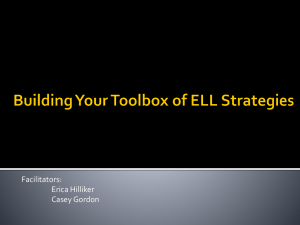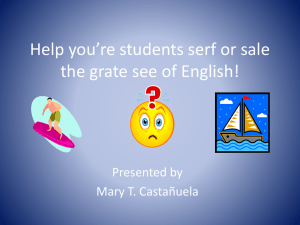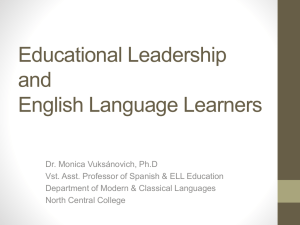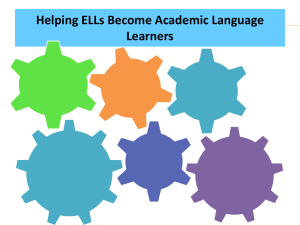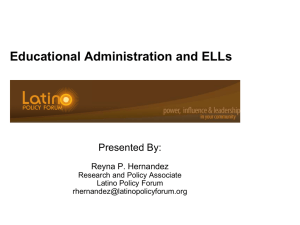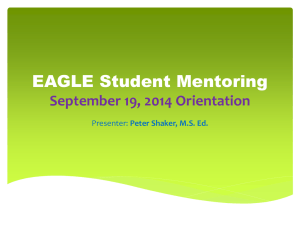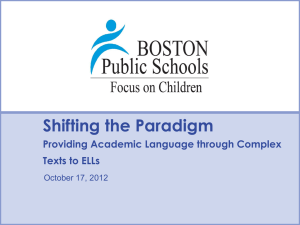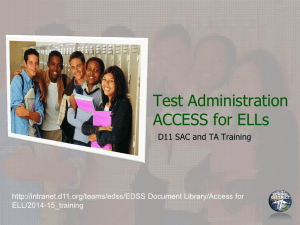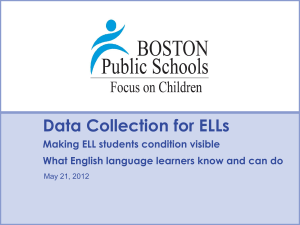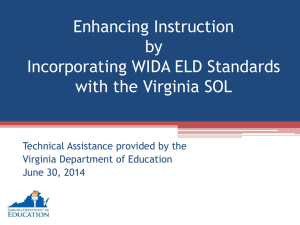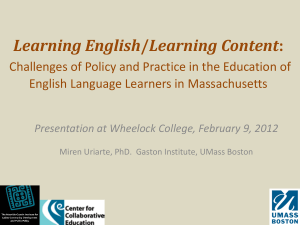Distinguishing between Learning Disabilities and
advertisement
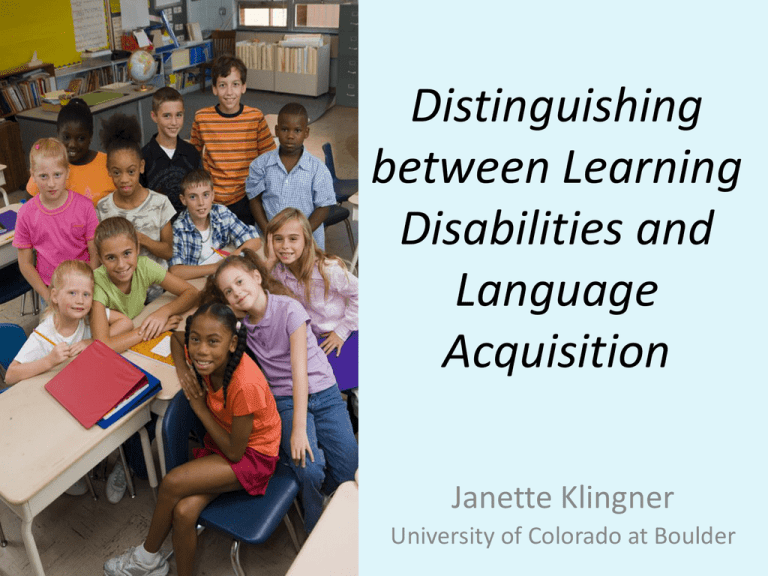
Distinguishing between Learning Disabilities and Language Acquisition Janette Klingner University of Colorado at Boulder First, what does the law say? Specific Learning Disability 34 CFR 300.8(c)(10) IDEA • A disorder in one or more of the basic psychological processes involved in understanding or in using language, spoken or written, that may manifest itself in the imperfect ability to listen, think, speak, read, write, spell, or to do mathematical calculations, including conditions such as perceptual disabilities, brain injury, minimal brain dysfunction, dyslexia, and developmental aphasia. – (ii) Specific learning disability does not include learning problems that are primarily the result of visual, hearing, or motor disabilities, of mental retardation, of emotional disturbance, or of environmental, cultural, or economic disadvantage. • A child has a specific learning disability, as defined in 34 CFR 300.8(c)(10), if: • The child does not achieve adequately for the child’s age or to meet State-approved grade-level standards in one or more of the following areas, when provided with learning experiences and instruction appropriate for the child’s age or Stateapproved grade–level standards: – – – – – – – – Oral expression. Listening comprehension. Written expression. Basic reading skills. Reading fluency skills. Reading comprehension. Mathematics calculation. Mathematics problem solving. • 34 C.F.R. § 300.534 Determination of eligibility. (b) A child may not be determined to be eligible under this part if— (1) The determinant factor for that eligibility determination is— (i) Lack of instruction in reading or math; or (ii) Limited English proficiency Required Observation • The group described in 34 CFR 300.306(a)(1), in determining whether a child has a specific learning disability, must: Use information from an observation in routine classroom instruction and monitoring of the child’s performance that was done before the child was referred for an evaluation; or • Have at least one member of the group described in 34 CFR 300.306(a)(1) conduct an observation of the child’s academic performance in the regular classroom after the child has been referred for an evaluation and parental consent, consistent with 34 CFR 300.300(a), is obtained. Language Acquisition or Learning Disability? The single biggest error made in placing ELLs into special education is: misinterpreting language acquisition as a learning or language disability We must help educators become better at making this distinction Language Acquisition or Learning Disability? To a large extent, determining whether an English language learner has a learning disability is a process of elimination. • Many factors must be considered and ruled out as possible reasons for a child’s struggles. • There are multiple possible explanations for every behavior. There are no tests that by themselves can definitively tell us whether the student has LD. It’s important to… Understand the second language acquisition process • Oral language • Written language • Literacy (and what can be confusing) Know possible characteristics associated with LD Look at the quality of instruction and students’ opportunities to learn Child Study Team Example James was at ESOL Level 1. Teacher: “My real concern is that when I give a direction (in English) he gives me a blank look, like he doesn’t understand. He’s lost.” She also noted that he had difficulty paying attention. Assistant principal: “A lot of children in ESOL have these difficulties.” Teacher: “But I think it’s more than that. It’s more a matter of higher level thinking.” This was accepted by the team and they proceeded to refer the student for an evaluation. They did not discuss his native language skills, and whether he exhibited these same problems in Haitian Creole. James’ Class (with almost all ELLs at beginning stages of proficiency) Teacher: “The last sense is the sense of touch. That means you feel. Feel the floor with your elbows. Can you feel it?” [OC: The students don’t understand what to do. There are no visual cues.] Teacher (yelling), “Some of you are being extremely rude.” Then she asks more calmly, “So did you feel the floor with your elbows, but do you normally feel with your elbow?” A few students respond, “No.” Teacher yells again, “You just finished telling me you were listening, Ezekiel. Were you lying to me? I’m only going to call on the people who are listening.”…Teacher: “If I wanted to eat cake, what sense would I use?”… “My point is that you use your sense of taste to decide if you like it.” Teacher (yelling): “Pay attention to me, not his shoes! His shoes aren’t going to give you a grade. I will.” “If one more person touches shoes, I’m going to throw it in the garbage. It’s important to make sure your shoes are tied, but not while I’m teaching.” Challenge 1: Many misconceptions about second language acquisition prevail. What should teachers understand about this process? Sequential Bilinguals and Simultaneous Bilinguals ELLs with LD exhibit difficulties in their first language as well as in English. • When students are sequential bilinguals, it is not hard to determine whether difficulties are evident in both languages. • When students are simultaneous bilinguals, it is much more challenging to determine if difficulties are the result of language acquisition or LD. • We need a new way to think about the process of simultaneous language acquisition (Escamilla). Misconception 1. Semilingualism is a valid concept and non-non classifications are useful categories. Reality Semilingualism and non-non categories result from tests that do not measure the full range and depth of language proficiencies among emerging bilingual students acquiring two languages. 2. Assessment and instructional frameworks developed for monolingual students are appropriate for ELLs. Literacy instruction and assessments in a second language differ in key ways from native language instruction. 3. The majority of ELLs in the U.S. are sequential bilinguals. The majority of ELLs in the U.S. are simultaneous bilinguals. This is especially true among long-term ELLs. 4. All ELLs learn English in the same The length of time it takes students to way at about the same rate. acquire English varies a great deal; many different variables affect the language acquisition process. 5. Errors are problematic and should be avoided. “Errors” are a positive sign that the student is making progress and are a necessary aspect of second language acquisition. 6. ELLs are not ready to engage in higher level thinking until they learn basic skills. ELLs are as intelligent as fully proficient peers and should have frequent opportunities to engage in higher level thinking. 7. Learning/acquiring more than one language at a time is confusing. Children around the world learn/acquire multiple languages simultaneously. Challenge 2: The characteristics of students with LD can be similar to those of English language learners acquiring English as a second language. How can we tell the difference? Behaviors Associated w/ LD Behaviors when Acquiring an L2 Difficulty following directions Difficulty following directions in English when they are not well understood Difficulty with phonological awareness Difficulty distinguishing b/w sounds not in L1 Slow to learn sound-symbol correspondence Confusion w/ sound-symbol correspondence when different than in L1 Difficulty remembering sight words Difficulty remembering sight words when word meanings not understood Difficulty retelling a story in sequence May understand more than can convey in L2 Slow to process challenging language May have poor auditory memory Slow to process challenging language not well understood Better auditory memory in 1st language Confused by figurative language Confused by unfamiliar figurative language May have difficulty concentrating Processing a second language can be tiring May seem easily frustrated May seem easily frustrated Challenge 3: Current LD identification models in RTI are based on assessing how well students respond to “research-based instruction.” What does it mean for instructional practices to be “research-based” for ELLs? What Do We Mean by “Research-based”? • The RTI model is based on the principle that instructional practices or interventions at each level should be based on scientific research evidence about “what works.” • However, it is essential to find out what works with whom, by whom, for what purposes, and in what contexts— With Whom? • When deciding if a practice is appropriate for implementation as part of an RTI model, it should have been validated with students like those with whom it will be applied. • The National Reading Panel report “did not address issues relevant to second language learning” (2000, p. 3). With Whom? • English language learners are often omitted from participant samples because of their limited English proficiency. • Yet language dominance and proficiency are important research variables and can affect treatment outcomes. • Leaving students out of studies limits the external validity and applicability of such studies, especially for those who teach culturally and linguistically diverse students. With Whom? • Research reports should include information about: – language proficiency – ethnicity – life and educational experiences (e.g., socio-economic, previous schooling) • Data should be disaggregated to show how interventions might differentially affect students from diverse backgrounds. By Whom? • Who is implementing the instructional practice? – Researcher? – Experienced teacher? – Specialist? – Paraprofessional? For What Purposes? • What is the goal of instruction? – Some widely touted instructional approaches help improve word identification skills, but not necessarily reading comprehension. – According to the Reading First Impact Study: “Reading First did not have statistically significant impacts on student reading comprehension test scores in grades 1-3.” In What Contexts? • Variations in program implementation and effectiveness across schools and classrooms are common (see the First Grade Studies for a classic example, Bond & Dykstra, 1967). – When students struggle, is it the program, the teachers’ implementation, or the school context? – What is it about the system that facilitates or impedes learning? In What Contexts? • It is essential to observe in classrooms. – Is the instruction appropriate for students’ language and learning needs? – What is the relationship between a teacher and students? – How does the teacher promote interest and motivation? • We draw different conclusions when several students are struggling rather than just a few ... More thoughts on research… • Experimental research studies tell us what works best with the majority of students in a research sample, not all students. • Some practices may be effective but have not yet been researched. • Qualitative research helps us understand why a practice works or not and factors that can affect implementation. • Observation studies in the classrooms of effective teachers tell us a lot about the attributes of successful teachers and the characteristics of effective instruction. • With RTI, if a child does not make adequate progress with research-based instruction that is presumed “to work,” the assumption is made that the child must have a deficit of some kind. – How do we ensure that the child has in fact received culturally and linguistically responsive, appropriate, quality instruction? – As with earlier identification criteria, this model must be based on students having received an adequate “opportunity to learn.” Opportunity to Learn? • Instruction by a teacher who lacks preparation in teaching English language learners and believes she is using generic “research-based” practices • Most students in this class are at beginning levels of English proficiency First Grade Class The whole Class is sitting in a circle, with the teacher seated at the head. Teacher says, “Yesterday, how many of you knew your sight words? One student speaks out, “One?” Another, “Three?” Teacher replies, “You are right. Three students were able to tell me their sight words. We need to practice these words; we are really behind. Every one of you should know these sight words by now. You need to practice these at home. Don’t you practice these at home?” Teacher says this with frustration in her face and voice. Teacher states, “Only those 3 students will be able to pull from the treasure chest.” … Teacher begins sight words practice and holds up index cards with-Big, My, See, Like, I, At, This, And, Up, Have, Too. Students repeat sight words as Teacher holds up index cards. This is a repetitive process. She then holds up the word “Big” without saying anything. One student says the word “Big.” She holds up a another. “See.” The same student says the word again. She holds up the word “see” again and tells the student who knew the previous answer not to say anything. Pause. Another says “see.” She continues to go through this process with all the words, and says, “Okay guys, you need to practice these at home, you are not paying attention, you should have known these words by now.” (Orosco, 2007) Challenge 4: Some recommendations emphasize the similarities between learning to reading in English as one’s first or a second language. Yet there are also important differences teachers should understand. • There are important differences between learning to read in one’s L1 and L2 (August & Shanahan, 2006; Goldenberg, 2008). • Learning trajectories for emerging simultaneous bilinguals are not well understood. • Benchmarks and expected rates of progress may not be the same (Hopewell, Escamilla et al., 2012; Linan-Thompson, Cirino, & Vaughn, 2007). • Many ELLs have a gap between their English word reading and their word knowledge and comprehension (Mancilla-Martinez & Lesaux, 2011). • Some recommendations put too much emphasis on phonological awareness and letter naming at the expense of other skills, such as oral language, vocabulary, and comprehension (e.g., the IES Practice Guide for ELLs). 90The Gap between Reading Words & Comprehending Text (Lesaux) Grade 4 80 Percentile Rank Grade 5 70 Grade 6 60 Grade 7 Grade 8 50 40 30 20 10 0 Word Reading Fluency Oral Language Reading Comprehension Factors that Influence Reading for English Language Learners Reading skills in L1 & L2 Oral proficiency in L1 & L2 Interest and Motivation Learning context Teacher’s skills & behaviors Instructional practices Challenge 5: How can we tell which English language learners to refer for a special education evaluation? What information do we need to make that decision? Guiding Questions • When a child shows signs of struggling, the first step should be to observe in her classroom. – Is instruction targeted to and appropriate for the student’s level of English proficiency and learning needs? – Is the teacher implementing appropriate research-based practices with fidelity? • If the teacher is modifying practices, for what reasons? – Does the classroom environment seem conducive to learning? Decision Points when ELLs Struggle with Reading Are most of the student’s true peers succeeding? • Look at how many ELLs are struggling. • If the majority of ELLs are making little progress, the teacher should focus on improving instruction. • If most ELLs are doing well and only a few are struggling, the teacher should look more closely at what is going on with those individual students and consider that they may need additional support. George Batsche & David Tilly • If instruction seems appropriate and most ELLs in the class are thriving, the next step should be to collect student data: – Has consideration been given to the child’s cultural, linguistic, socioeconomic, and experiential background? – Have authentic assessments been used in addition to progress monitoring? – What tasks can the student perform and in what contexts? – Does the student differ from true peers in rate and level of learning? – Have the child’s parents been asked for their input? Assessing ELLs Multiple assessment methods are needed to provide a comprehensive view of learning. No single best test or assessment strategy. Different assessments tap into different skills and knowledge. Assessments should be used only for the purpose for which they were designed. A Common Scenario: Early Literacy Measures Lesaux Letter Names & Letter Sounds •Oral Language Vocabulary Word Learning Strategies Knowledge of word function or type Accuracy Phonological Word Reading Awareness READING COMPREHENSION Metalinguistic Skills •Text Characteristics Organizational structure Efficiency • Background Knowledge •Interest •Motivation •Understanding of Purpose Sentence structure The Comprehensive Assessment System • Many skills go into what we call “literacy”; we need measurements across different areas to fully gauge student progress. • The assessments currently being used only provide a partial assessment of literacy skills. • Oral reading fluency does not predict comprehension for English language learners like it does for fluent English speakers (Crosson & Lesaux, 2009). Case Study: Marta (a true story) Marta was tested, identified as having LD, and placed in my LD class before the beginning of 3rd grade. Her 2nd grade teacher had referred her for a special education evaluation because of a lack of academic progress. Based on the results of their battery of tests, the IEP team considered Marta to be low in both her home language (Spanish) and English. They believed that she had auditory processing deficits and showed a significant discrepancy between IQ and achievement. Marta had been in a bilingual program and received instruction in Spanish in kindergarten, but then her family had moved to a school without a bilingual program and she had been instructed in English only in 1st and 2nd grades. Marta’s parents described her as intelligent and very helpful at home with her younger siblings. They were concerned that Marta was not doing better in school, and trusted the school’s judgment that Marta needed special education. When Marta became my student in September, I assessed her in both Spanish and English using the Brigance and made the decision (in collaboration with her family and others) to provide her with Spanish literacy instruction (as well as intensive oral English language development). I used the Language Experience Approach (LEA)—she dictated stories to me in Spanish that she then learned to read. She “took off,” gaining 2 grade levels in Spanish reading in just a few months. She expressed a strong interest in also reading in English, and so in February I began English literacy instruction. I continued to use the LEA AND added DISTAR (plus thematic units based on interest). By June she was on grade level in English and above grade level in Spanish. We reassessed her eligibility for special education and found that she was ineligible. She was exited from the program. Is she a success story? YES, but…. • How can we make sure not to misidentify ELLs like Marta? In conclusion… Distinguishing between LD and language acquisition is a complicated process that requires a comprehensive approach to assessment that evaluates the "societal and educational context within which the child has developed” (Cummins, 1986). We must “shift from a within-child deficit paradigm to an eco-behavioral perspective” (National Association of School Psychologists, 2006). Questions? Janette.Klingner@ colorado.edu

